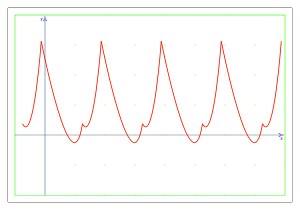Symmetric functions
As you might think, the functions can have different forms and some of them are symmetric, some are antisymmetric and others have different forms with no clear patterns.
The symmetries always depend on an axis (the mirror where the symmetry is referred to). So a symmetrical function must fulfill the following condition:
If
Particularly, if we have symmetry with respect to the axis 
Traditionally and for general agreement, we call even function the functions that satisfy
On the other hand, we can find the antisymmetric functions, which are functions that have one kind of symmetry with respect to an axis
These functions satisfy the condition:
Particularly, if we have antisymmetry with respect to the axis

Again for general agreement, we call odd function the functions that satisfy
Let's observe that the antisymmetric functions must satisfy, at some point
Let's see some examples of symmetric and antisymmetric functions:
Example
The function
Example
The function
Example
The function
Example
The function
Periodic functions
We will call periodic functions those that are repeating one part of the function.
We can say also that a periodic function will have period

In the plot we can clearly see a periodic behavior of the function.
Let's see a few examples of periodic functions.
Example
The function
Example
The function
Intersection points
When we have to plot a function, it often turns out to be very useful to know the exact point in which the function cuts both the
To know exactly these points, we must follow this procedure:
- Intersection with the
Let's see an example:
Example
Let's take the function
Consequently we will say that the function has the point
- Intersect with the
Let's see an example:
Example
Let's take the function
and it turns out that we find two points, the
